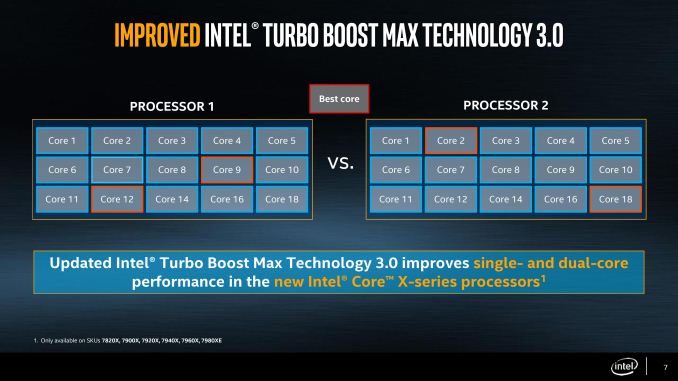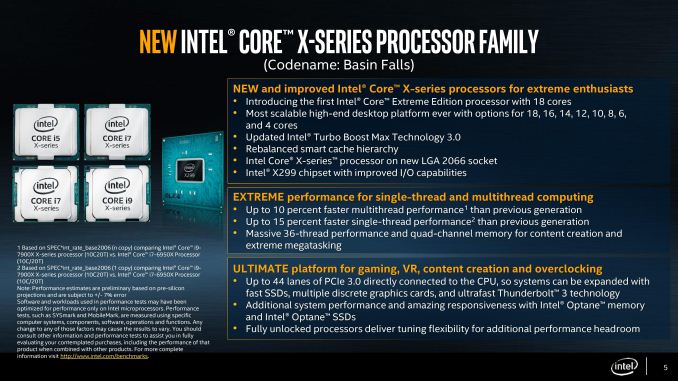Intel Announces Skylake-X: Bringing 18-Core HCC Silicon to Consumers for $1999
by Ian Cutress on May 30, 2017 3:03 AM ESTAnnouncement Four: AVX-512 & Favored Core
To complete the set, there are a couple of other points worth discussing. First up is that AVX-512 support coming to Skylake-X. Intel has implemented AVX-512 (or at least a variant of it) in the last generation of Xeon Phi processors, Knights Landing, but this will be the first implementation in a consumer/enterprise core.
Intel hasn’t given many details on AVX-512 yet, regarding whether there is one or two units per CPU, or if it is more granular and is per core. We expect it to be enabled on day one, although I have a suspicion there may be a BIOS flag that needs enabling in order to use it.
As with AVX and AVX2, the goal here is so provide a powerful set of hardware to solve vector calculations. The silicon that does this is dense, so sustained calculations run hot: we’ve seen processors that support AVX and AVX2 offer decreased operating frequencies when these instructions come along, and AVX-512 will be no different. Intel has not clarified at what frequency the AVX-512 instructions will run at, although if each core can support AVX-512 we suspect that the reduced frequency will only effect that core.
With the support of AVX-512, Intel is calling the Core i9-7980X ‘the first TeraFLOP CPU’. I’ve asked details as to how this figure is calculated (software, or theoretical), but it does make a milestone in processor design. We are muddying the waters a bit here though: an AVX unit does vector calculations, as does a GPU. We’re talking about parallel compute processes completed by dedicated hardware – the line between general purpose CPU and anything else is getting blurred.
Favored Core
For Broadwell-E, the last generation of Intel’s HEDT platform, we were introduced to the term ‘Favored Core’, which was given the title of Turbo Boost Max 3.0. The idea here is that each piece of silicon that comes off of the production line is different (which is then binned to match to a SKU), but within a piece of silicon the cores themselves will have different frequency and voltage characteristics. The one core that is determined to be the best is called the ‘Favored Core’, and when Intel’s Windows 10 driver and software were in place, single threaded workloads were moved to this favored core to run faster.
In theory, it was good – a step above the generic Turbo Boost 2.0 and offered an extra 100-200 MHz for single threaded applications. In practice, it was flawed: motherboard manufacturers didn’t support it, or they had it disabled in the BIOS by default. Users had to install the drivers and software as well – without the combination of all of these at work, the favored core feature didn’t work at all.
Intel is changing the feature for Skylake-X, with an upgrade and for ease-of-use. The driver and software are now part of Windows updates, so users will get them automatically (if you don’t want it, you have to disable it manually). With Skylake-X, instead of one core being the favored core, there are two cores in this family. As a result, two apps can be run at the higher frequency, or one app that needs two cores can participate.
Availability
Last but not least, let's talk about availability. Intel will likely announce availability during the keynote at Computex, which is going on at the same time as this news post goes live. The launch date should be sooner rather than later for the LCC parts, although the HCC parts are unknown. But no matter what, I think it's safe to say that by the end of this summer, we should expect a showdown over the best HEDT processor around.


















203 Comments
View All Comments
ddriver - Tuesday, May 30, 2017 - link
You fail miserably at making a point. I am comparing the latest and greatest both companies had on the market at the time. Now back under the bridge with you!Ranger1065 - Wednesday, May 31, 2017 - link
ddriver, I always respect your perspective at Anandtech particularly when it differs from general opinion as, thankfully, it often does. I also admire the tenacity with which you stick to your guns. The comments section would certainly be an infinitely more boring and narrow minded place without you. Keep up your excellent posts.fanofanand - Wednesday, May 31, 2017 - link
+1He is the most entertaining person here, I love reading his take on things.
Ro_Ja - Thursday, June 1, 2017 - link
Your comment is the reason why I scroll down this section.Hxx - Tuesday, May 30, 2017 - link
I dont think you understand the meaning of the word desperate at least in this context. Maybe intel redesigned their release schedule in response to ryzen who the f knows except their upper mngmt and thats irrelevant, in the end what matters is what the consumer gets and for what PRICE. If intel was truly desperate that we would have at least seen a price cut in their current cpu lineup and Im not seein that. These CPUs are also targeted at the enthusiast crowd and nowhere near Ryzen's price point so wheres the desperation again?rarson - Wednesday, May 31, 2017 - link
The marketing alone, never mind the fact that Intel's cannibalizing their own sales selling HCC chips to consumers, reeks of desperation.DC Architect - Tuesday, May 30, 2017 - link
If you think CIO's give a damn about "brand loyalty" over profit margins then you are high. Also... 99.8% of the people using computers couldn't tell you what a motherboard IS or what components are in their "hard drive box" let alone have any loyalty to those brands. The guys making the call on these kinds of decisions could give a rats ass what the guy on the floor wants when he can increase the margins by 100% and only lose 1% in IPC.We're not talking about server CPU's here that are parsing huge databases 24/7. That 1-5% IPC loss for your Joe Shmoe user matters a lot less when you can tell the CEO that you only need half your normal operating budget this year for workstations.
Icehawk - Tuesday, May 30, 2017 - link
Brand loyalty is HUGE in the corporate/server marketplace, it's foolish to think otherwise. Most large companies lock in with one or two vendors and buy whatever they offer that closest fits their needs or are able to get custom orders if the volume is enough. Never in my 19 years in IT have I seen or used a single AMD server, and only in a very few (crappy) laptops. Even back in the Athlon days we would stick with Intel as they are a known quantity and well supported.Hell where I work now they buy i7s for their grunts when an i3 would be fine - but it is easier on accounting to just deal with one SKU and easier for IT as well to only deal with a single configuration. The hardware cost differential can be offset by factors such as these.
On non server side, I am really happy to see AMD doing better - I probably will go with the 7820 though as I do value single threaded a lot (gaming) and also do a ton of reencoding to x265 where more cores would really help.
theuglyman0war - Thursday, June 8, 2017 - link
to be fair... I assume all those TBD's certainly do represent an "upcoming" response to ryzen that we would not had seen to whatever degree the final form takes. And that is awesome.The healthy competitive market is officially TBD! :)
Anyone with any reason is waiting for the dust to settle and the market to correct itself with a consumer response the way healthy markets should function.
alpha754293 - Friday, June 2, 2017 - link
It's "funny" reading your comment only because so much of it is so wrong/unfounded on so many levels.I used to be a strictly AMD-only shop because they offered a much better economic efficiency (FLOP/$).
Now, pretty much all of my new systems are all Intel because Intel is now better in terms of FLOP/$. (And also in just pure, brute-force performance).
AMD really screwed the pooch when they went with the shared FPU between two ALU design in their MCMs rather than having a dedicated FPU PER ALU (something which the UltraSPARC Niagara T1 originally did, and then revised it with T2).
It was choking/strangling itself. WHYYY Derrick Meyer (being a former EE himself) would allow that is beyond me.
I pick it pretty much solely based on FLOP/$ (as long as the $ piece of it isn't SO high that I can't afford to pay for it/buy it).
There ARE some times when you might want or even NEED a super high powered, many, many many core count system because if you can do a lot of development work deskside, you refine your model piece by piece without having to spend a great deal of time re-running the whole thing always, everytime; and once your model is set up, THEN you ship it/send it off to the cluster and let the cluster go at it.
If you are doing your debugging work on the cluster, you're just taking valuable time from the cluster away. (Like when I am doing some of my simulation stuff, the volume of data that gets generated is in the TBs now, so having to send the data back and forth when you have "bad" data (say from a run that errored out) - you're literally just shovelling crap around, which takes time and doesn't do anything useful or productive.
re: your 70 active systems
On the assumption that they're ALL 3770K chips, that's about 280 cores. You can probably get yourself a bunch of these:
http://www.ebay.com/itm/2U-Supermicro-6027TR-HTRF-...
to replace your compute farm.
I would be willing to bet that between 2-4 of those can replace your entire farm and still give you better FLOP/$.